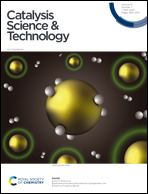SO2 deactivation mechanism of NO oxidation and regeneration of the LaCoO3 perovskite†
Abstract
The deactivation mechanism and methods to cope with the poisoning by SO2 of LaCoO3 perovskite-based NO oxidation catalysts were investigated. The LaCoO3 perovskite was synthesized by a sol–gel method and the fresh, sulphate-deactivated and regenerated catalysts were characterized by X-ray diffraction, X-ray photoelectron spectroscopy, H2-and soot-temperature programmed reduction, temperature programmed desorption and diffuse reflectance infrared Fourier transform spectroscopy. The SO2 poisoning strongly affected the NO oxidation activity. It was demonstrated that the deactivation mechanism proceeds in two stages: initially the active sites with a basic character are blocked by SO3 and subsequently the lanthanum sulphate salts grow progressively on the surface and cobalt is unaffected. Above 500 °C, the surface bound sulphates become mobile and migrate into the bulk of the catalyst. Several prevention and regeneration methods were proposed and tested. By mixing the catalyst with Ca(OH)2 as an adsorbent nearly 50% of the original activity was retained. Regeneration by diesel soot was presented here for the first time, where the blocking oxygen can spill over to the soot oxidizing it and releasing the bound sulphur as SO2 and CO2. Furthermore, a facile regeneration method was explored by washing the deactivated catalyst to dissolve the small amounts of sulphates on the surface.



 Please wait while we load your content...
Please wait while we load your content...